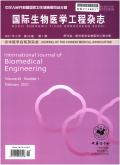Effect of Thbs4 gene editing BMSCs transplantation on VEGF and Ang-1 in diabetic hind limb ischemia rats and related mechanism
引用次数: 0
Abstract
Objective To investigate the effects and the mechanism of thrombospondin 4 (Thbs4) gene-edited bone marrow mesenchymal stem cells (BMSCs) transplantation on vascular endothelial growth factor (VEGF) and angiopoietin-1 (Ang-1) in diabetic rats with hind limb ischemia. Methods Thirty Sprague-Dawley rats were randomly divided into the model group, BMSCs treatment group and Thbs4-BMSCs treatment group on average. After constructing the type Ⅱ diabetic rat model with hind limb ischemia, 100 μl normal saline, BMSCs suspension and Thbs4-BMSCs suspension (cell number: 2×106) were locally injected into the ischemic injury area of rats for the model group, BMSCs group and Thbs4-BMSCs group, respectively. The rats were sacrificed on the 14th day after stem cell transplantation, and the muscle tissues near the ischemic area were collected. The relative expression of VEGF and p-Smad2/3 protein was detected by Western Blot. The Ang-1 protein expression was detected by immunofluorescence staining. The levels of related genes were detected by qRT-PCR, and the von Willebrand Factor (vWF) protein expression was detected by immunohistochemistry staining. Results The relative expression levels of VEGF, Ang-1 and vWF protein in the Thbs4-BMSCs group were significantly higher than those in the model group and BMSCs group (VEGF protein: P<0.01 and P<0.05). The mRNA expression of VEGF and Ang-1 were significantly up-regulated, the differences were statistically significant(VEGF mRNA: all P<0.01; Ang-1: P<0.01 and P<0.05). The expression of p-Smad2/3 protein in the Thbs4-BMSCs group was significantly higher than that in the model group and the BMSCs treatment group (all P<0.01). The expression of p-Smad2/3 protein was significantly decreased after the addition of p-Smad2/3 pathway inhibitor, the differences were statistically significant (P<0.05). Conclusions Thbs4-BMSCs transplantation can effectively promote angiogenesis in diabetic rats with hind limb ischemia, and the effect of angiogenesis may be related to the activation of Smad2/3 signaling pathway. Key words: Diabetes mellitus; Hind limb ischemia; Mesenchymal stem cell transplantation; Thrombospondin 4; AngiogenesisThbs4基因编辑BMSCs移植对糖尿病后肢缺血大鼠VEGF和Ang-1的影响及其机制
目的探讨血小板反应蛋白4 (Thbs4)基因编辑骨髓间充质干细胞(BMSCs)移植对糖尿病后肢缺血大鼠血管内皮生长因子(VEGF)和血管生成素-1 (Ang-1)的影响及其机制。方法30只sd大鼠随机分为模型组、骨髓间充质干细胞治疗组和thbs4 -骨髓间充质干细胞治疗组。建立Ⅱ型糖尿病后肢缺血大鼠模型后,模型组、BMSCs组和Thbs4-BMSCs悬液(细胞数2×106)分别局部注射100 μl生理盐水、BMSCs悬液和Thbs4-BMSCs悬液于大鼠缺血损伤区。干细胞移植后第14天处死大鼠,收集缺血区附近肌肉组织。Western Blot检测VEGF和p-Smad2/3蛋白的相对表达量。免疫荧光染色检测Ang-1蛋白表达。采用qRT-PCR检测相关基因表达水平,免疫组化染色检测血管性血友病因子(vWF)蛋白表达。结果Thbs4-BMSCs组VEGF、Ang-1、vWF蛋白相对表达量均显著高于模型组和BMSCs组(VEGF蛋白:P<0.01和P<0.05)。VEGF、Ang-1 mRNA表达均显著上调,差异均有统计学意义(VEGF mRNA:均P<0.01;Ang-1: P<0.01和P<0.05)。Thbs4-BMSCs组P - smad2 /3蛋白表达量显著高于模型组和BMSCs治疗组(均P<0.01)。添加P - smad2 /3通路抑制剂后,P - smad2 /3蛋白表达显著降低,差异均有统计学意义(P<0.05)。结论Thbs4-BMSCs移植可有效促进糖尿病后肢缺血大鼠血管生成,其作用可能与激活Smad2/3信号通路有关。关键词:糖尿病;后肢缺血;间充质干细胞移植;血小板反应蛋白4;血管生成
本文章由计算机程序翻译,如有差异,请以英文原文为准。
求助全文
约1分钟内获得全文
求助全文

 求助内容:
求助内容: 应助结果提醒方式:
应助结果提醒方式:


